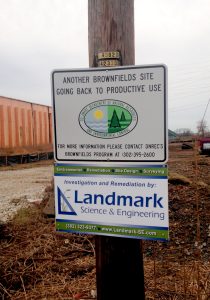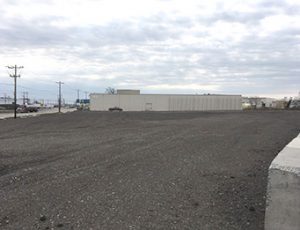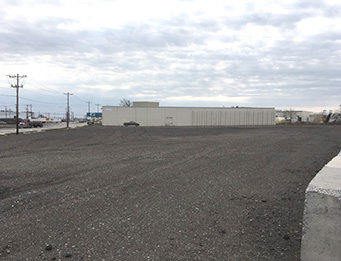The Terminal Avenue redevelopment project located near the entrance to the Port of Wilmington is a notable example of the Delaware Brownfields Development Program in action.
A Very ImPORTant Region
Industrial properties within the vicinity of the Port of Wilmington are a valuable commodity. Finite in numbers, their geographic location near the confluence of the Delaware and Christina Rivers, as well as to I-495, cultivates commerce opportunities. As important to the community as it is today, the Port also has a rich history dating back to 1638 when Swedish settlers aboard the Kalmar Nyckel first landed on the bank of the Christina River. The Port of Wilmington has remained crucial for the importing and exporting of cargo for centuries. But along with the rich history comes modern-day challenges. Many industrial proprieties near the Port are now contaminated. Their cleanup is a necessary and urgent price to pay for decades of polluting industrial land practices. The future economic success of this area is dependent on the clean up and redevelopment of abandoned port properties.
Delaware Brownfields Development Program

Recognizing the social, economic, and environmental benefits of the remediation and redevelopment of “Brownfields,” the state’s DNREC created the Delaware Brownfields Development Program in 2004. (“Brownfields” are defined as vacant, abandoned, and/or underutilized properties that are also likely contaminated.) The Program encourages the purchase and redevelopment of Brownfield sites by providing financial assistance to new owners. New owners can receive assistance for the investigation and remediation of any hazardous substances present within a property. This creates a win-win situation where the new owners can develop the property following its clean up.
There are currently over 300 certified Brownfield sites throughout Delaware. About 26 sites are situated within the vicinity of the Port of Wilmington between South Heald Street and Terminal Avenue. Landmark Science & Engineering has investigated and participated in the active remediation of several of those 26 sites. As Landmark’s Environmental Engineer and head of the Remediation Division, I am experienced in assisting land owners with the production and successful execution of their “Brownfields Development Agreement.” This Agreement outlines the specific investigations and remedial actions proposed to neutralize any contaminants present within their property.
Terminal Challenges
The “Terminal Avenue Redevelopment Project” is one such example. In 2013, a Client reached out to our Remediation Division because they were interested in purchasing a 2.1-acre site near the Port of Wilmington. Like many properties near the Port, the Subject Property had its share of advantages and disadvantages. Obvious advantages were its proximity to the port, the Christina River, and to I–495. The main disadvantage was the typical one for that region: the site was contaminated.
The site also contained approximately 1.18 acres of tidal wetlands within its central portion. That meant that well over half of the property was comprised of centrally-located wetlands. The tidal wetlands presented two challenges. The first being that they significantly limited the square footage available for land development. The second was that they hydrologically connected the site to the adjacent river, providing daily opportunities for the on-site contaminants to spread into the Christina River.
Both the on-site wetlands and soil were contaminated with metals (including high concentrations of arsenic), SVOC (semi-volatile organic compounds), diesel-range organics, one VOC, and one pesticide. The source of the contamination was likely another Brownfields site upstream. The contaminants were likely transported onto the site via a tidally-influenced ditch into the on-site wetlands.
A Dirty Past can lead to a Bright Future and a Landmark Project

Based on our experience and the existing site conditions, we determined that the most practical option to contain and isolate the on-site contamination and prevent daily tidal migration into Christina River was to fill in the contaminated wetlands and permanently cap the entire site.
Landmark facilitated the purchase of the property and its enrollment into the Delaware Brownfields Development Program. We then coordinated with DNREC and conducted an investigation of the site to document the contamination. Based on the supporting data, the regulatory agencies agreed that filling the wetlands in order to permanently cap the site was the most practical remedial solution. Landmark designed remediation processes which included obtaining a Nationwide Permit 38 (“Clean-up of Hazardous and Toxic Waste”) to fill the contaminated wetlands. Prior to capping the site, a structural retaining wall with wing walls was constructed along the western property line, and a 30” diameter rigid plastic drain pipe was placed in the existing drainageway between the wing walls and existing culvert at Terminal Avenue in order to maintain tidal flow. The site was then filled with clean imported materials and capped with asphalt millings to a finish elevation above the 100-year floodplain.
The property is now a flat, 2.1-acre commercial site, completely paved with compacted asphalt millings, and located fewer than 700 feet from the main entrance of the Port of Wilmington. Its future is bright (and clean) thanks to the Landmark remediation team!
Contact Doug Seavey P.E., head of Landmark’s Remediation Division, if we can help you take advantage of the Delaware Brownfields Development Program. Our team can assist you with maximizing your property’s value and prospects. See more about our Environmental Site Remediation services.

